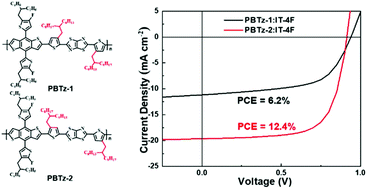Two conjugated donor polymers (PBTz-1 and PBTz-2) based on benzo[1,2-b:4,5-b′]dithiophene and thiazolothiazole (TzTz) with different side chain (2-hexyldecyl) positions were designed and synthesized. Both polymers had similar optical and electrochemical bandgaps as well as deep HOMO levels, but significantly different aggregation behaviors in solution and photovoltaic performances in NF PSCs. Combining their absorption spectra, atomic force microscopy and X-ray diffraction measurements, we found that PBTz-1 exhibited stronger aggregation in solution and crystallization in film than PBTz-2. When they were blended with a non-fullerene acceptor (IT-4F), their blend films showed large differences in organizations and morphologies. In PSCs, the power conversion efficiency (PCE) of the PBTz-1:IT-4F-based PSC was only 6.2%, while the PCE of the PBTz-2:IT-4F-based PSC was up to 12.4%.
